#Aircraft Engine Sensors
Explore tagged Tumblr posts
Text
#Honeywell aerospace parts#Honeywell aircraft components#Honeywell avionics parts#Honeywell engine parts#Honeywell sensors and actuators
0 notes
Note
who are the main characters of Bad Ending? i think that setting is sooo cool and sooo horrifying so i'd love to know more about it. peak sci-fi in my heart
Here are the most developed of Bad Ending’s individuals. There is no story nor a single timeframe, since Bad Ending takes place between the modern day and the death of all life.
Earthlings
Bitedown agents Intel & Close-quarters combat (Molar)
Intel is prenatally nooengineered to rapidly and eagerly absorb information from senses of customizable priority. Typically this is vision, but he can be attuned to scent, sound, touch, and specific ranges of each. This was managed via a nootically mapped and tactically modified form of autism.
Molar is also prenatally nooengineered to scope rooms out for weapons and maneuverability. She does this passively and without stress, but can be activated into a hyperaggressive state where she uses any means to kill designated targets. Her molars have been replaced and her reinforced adductors can break bone. She is unemotive and docile, requiring very little mental stimulation.
Sunflower Complex is the piloting system for a brown windowless reconnaissance jet.
Floret 1 & 2 are two surgically linked meshes that are clones of the same donor. Floret 1 is the conscious pilot of the Complex’s aircraft. Floret 2 is subconscious and serves as redundant support for the Complex’ reflexes and vital organs.
Floret 3 is a small mustard seedlet that pilots the jet if the organic florets are incapacitated or ejected.
MOUS
A surgically modified surveillance agent with built-in sonar, LiDAR, and FLIR capabilities. He is capable of standing very still for extended periods of time thanks to locking artificial muscles. His mechanical insides are cooled by two intakes either side of his neck, filtering into his lungs.
GOSSIP RING
A surveillance satellite housing a dozen nootically linked meshes. They analyze data amongst themselves.
GOD’S FAVORITE
A large wormlike mobile particle accelerator and cenote sensor. Cenotes are holes in time’s past strata.
Balanceaban, “BAAL”
Mexico’s adept war coordinator seedlet. He spearheads resource distribution, medicine, and weapon lethality, sharing his research freely with the world that he brought to its knees.
Cygnet
The US’ war seedlet in response to BAAL. It is daunted by its assigned task of recovering the military footing of a collapsing nation that sits beside the world’s deadliest superpower.
Throneroomers
<Harvest feeds many> “Harvest”
Model-turned-editor for a magazine of fashion and physicality for the Ministry of Arts, a pangovernmental collective promoting every corner of the Thronal supercontintent’s artistic expression.
<Five summers> “Five”
A fashion and physicality model, and Harvest’s closest friend.
<Little bell>
Harvest’s only birthed child, now a software engineer for the Pursuit of Sleep superproject, a global pooling of intellectual and material resource to eliminate the distant threat.
#char speaks#ask#ghost-bird1#bad ending#ba intel#ba molar#sunflower complex#gossip ring#god’s favorite#Balanceaban#cygnet#sophont ai#momg#Bongspider#five summers#crowns#Thank you! ❤️
85 notes
·
View notes
Text


DID YOU KNOW? By SR-71 Pilot, Stormy Boudreaux
The SR-71 carries more fuel by weight than the weight of the airframe and engines combined. Carries 80,000 pounds of fuel. The dry weight of SR-71 w/o fuel is 56,600 to 60,000 pounds (varies due to various sensor loads).
Which brings me to discuss why fuel in aircraft is measured in pounds instead of gallons. The weight of the fuel, not the volume , is the critical factor in determining the aircrafts performance and stability. Fuel volume can change pretty significantly with temperature, but the weight of the fuel remains roughly the same )less the fuel used to climb) . It was noted in the older piston engine aircraft refueled to full tanks on a hot day on the ground would indicate on gauges based on volume to have significate decreases once flown to 30 or 40,000 feet where the temperature are much colder. By using capacitance probes in tanks that convents the measurement into pound of fuel. Fuel weight or mass is the energy available for flight the volume measurement is in error due to fuel becoming denser as it gets colder at altitude. By using pounds you can accurately calculate the fuel consumption as well as the center of gravity through out the flight regardless of temperature variations. Thank you, Stormy.
Linda Sheffield
@Habubrats71 via X
#sr 71#sr71#sr 71 blackbird#blackbird#aircraft#usaf#lockheed aviation#skunkworks#aviation#mach3+#habu#reconnaissance#cold war aircraft
71 notes
·
View notes
Text

The F-15EX is a modernized variant of the F-15 Eagle fighter jet, upgraded with advanced avionics and capabilities. It offers improved air-to-air combat and air-to-ground strike capabilities compared to earlier F-15 models. Key features include:
Upgraded avionics with a new glass cockpit, improved radar, and advanced communication systems
Improved radar system (APG-82) for air-to-air and air-to-ground capabilities
Enhanced air-to-air combat capabilities with increased range and accuracy, and improved maneuverability
Ability to deliver accurate and precise strikes against ground targets with advanced precision-guided munitions (JDAM)
Longer range due to advanced engines and improved fuel efficiency
Improved maneuverability, including roll rate and sustained turn rates
Advanced electronic warfare capabilities, including detection and jamming of enemy radar systems
Advanced communication systems for communication with other aircraft and ground stations
Overall, the F-15EX is a highly capable fighter jet, but it is an older design compared to newer fighter jets like the F-22 Raptor or F-35 Lightning II, which may have superior stealth capabilities and advanced sensor systems
127 notes
·
View notes
Text
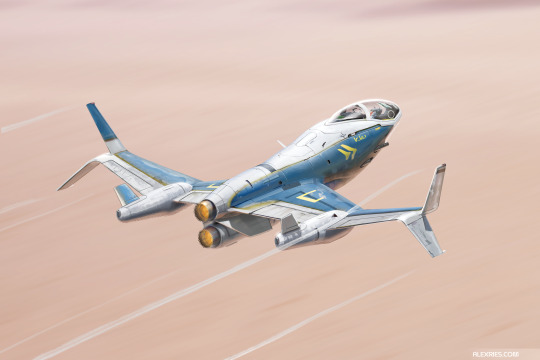
The Tandem Call was a small fighter developed by over-eager birrin engineers as a way to relearn aviation knowledge lost in the Fall. A variety of unconventional control surfaces, including split ailerons and moving winglets, were all tossed into this single airframe to test several aerodynamic concepts. The team never expected that the Tandem Call would ever fire a shot in anger.
In its test bed role weapons, including a powerful cannon, were added. Onboard magazines and under-wing stores could carry a variety of experimental guided and unguided munitions for use on Kiln test ranges. The bubble canopy gave the pilot excellent visibility, but the Tandem Call lacked radar. This shortcoming was partly rectified when the Reclamation wars began with a detachable underwing sensor pod.
During development the team was also only given surplus small jet powerplants: a second turbine was added in ventral pod when the vehicle was found to be underpowered in combat tests, though this could be easily removed for non-combat reconnaissance missions to increase endurance. This pod necessitated the addition of longer landing gear housed in nacelles extending beyond the wing trailing edge.
Despite the idiosyncratic design, the Reclamation wars pulled the Tandem Call into service, its potent cannons felling slower enemy aircraft and strafing ground targets.
Despite its experimental nature, the vehicle was put into serial production to fulfil the need for air power in the explosively escalating conflict, giving rise to a legendary group of pilots who were able to use the idiosyncratic aircraft to great effect against what were increasingly sophisticated adversaries
398 notes
·
View notes
Text
In the fall of 2022, Kyiv faced a difficult problem. The Russians were bombarding Ukrainian cities with swarms of Iranian Shahed drones. The challenge was spotting them, since their low altitude, small size, and stealthy design made them hard to follow on radar.
A pair of Ukrainian engineers quickly jury-rigged a solution. Today, the country is blanketed with a network of 9,500 microphones mounted on six-foot-tall poles. The microphones, which are attached to cell phones, track the Shaheds by sound (the propeller-driven drones have loud engines) and send that data to a central system that calculates their courses. That information is then passed on to iPad-wielding soldiers in gun trucks that shoot down the slow-moving drones. Each sensor pole in the network costs less than $500—which makes the entire network, known as Sky Fortress, cheaper than a pair of Patriot missiles.
I experienced Sky Fortress in action during an extended visit to Kyiv last fall. Shaheds, which sound a lot like lawn mowers in the sky—passed over my apartment building several times. Ukrainian air defenses succeeded in shooting down the majority of them, and they did so at a fraction of the cost of Western-supplied anti-aircraft systems.
All this should explain why I wasn’t entirely surprised when I heard about last weekend’s shrewd Ukrainian drone attack on air bases deep inside Russia. Operation Spiderweb, which appears to have inflicted serious damage on Russia’s strategic bomber fleet, brilliantly exemplifies the Ukrainian way of war, born out of Kyiv’s struggle to survive attacks from an enemy with far larger manpower and resources. This disparity has forced the Ukrainians to get creative, bypass traditional bureaucracies, and empower soldiers and entrepreneurs in the search for unorthodox solutions that quickly address battlefield needs. Since it largely ignores traditional military hierarchy and its slow, top-down processes, one might call Ukraine’s new philosophy “flat war.”
Flat war is less a planned strategy than an organic reflection of Ukraine’s predicament. When Russia launched its full-scale invasion in February 2022, Ukraine’s defense establishment was still dominated by top-heavy, Soviet-style structures. But military and political leaders quickly shifted to a nimbler approach, bringing private companies directly into the process of developing weapons and giving front-line units greater leeway to develop and procure their own systems. In some ways, that shift reflects the country’s recent political history. Decentralization has been a pillar of reform efforts over the past decade or so, which might explain why it has been embraced so thoroughly by soldiers.
One of the most striking traits of the new philosophy is its emphasis on cost-effectiveness. Each of the 117 drones deployed in Operation Spiderweb cost something in the ballpark of $1,000. Kyiv has said that the attack inflicted billions of dollars of damage on Russia, which could well be true given satellite images confirming that around a dozen Russian bombers were destroyed. No matter the actual figure, the cost-benefit calculation skews dramatically in Ukraine’s favor. And the precise number of lost aircraft doesn’t even begin take into account the broader effects on the Russian economy, which is now being thrown into chaos as paranoid security officials stop every truck on the road in search of more drones.
From a Ukrainian perspective, the most unusual thing about Operation Spiderweb is precisely the fact that President Volodymyr Zelensky appears to have been directly involved. Today, many of the most vital warfighting decisions are made not by the president’s office or the Ministry of Defense, but at the brigade level—the fundamental building block of the Ukrainian military. Brigades recruit their own soldiers (whom they can divert to technology development work according to their qualifications), liaise directly with companies about the weapons they need, and even manufacture drones in their own 3D-printing facilities. (Zelensky recently said that Ukraine made 2.2 million drones in 2024; the production target for this year is more than double that.)
In the best cases, the flattening of distance between decision-makers and warfighters promotes rapid innovation. Not many militaries in the world would have had the audacity to field a missile-equipped naval drone of the kind that shot down two Russian fighter jets over the Black Sea last month. Operating outside bureaucratic constraints in the months after Russia launched its invasion, Ukrainian tech experts quickly developed an app that allowed troops, spotters, and artillery units to coordinate attacks. Ukrainians have also made remarkable strides in adapting artificial intelligence systems to the battlefield. Kateryna Bondar, a fellow at the Center for Strategic and International Studies, has outlined how some of the drones in Operation Spiderweb used AI applications to hit their targets.
Speed has become a weapon. “Ukraine’s advantage has not been in the individual technologies it has deployed, but in its ability to regularly outpace Russia in the innovation cycle,” wrote Joyce Hakmeh, deputy director of the international security program at Chatham House, in a recent report. And Hakmeh’s right. Ukraine’s strength hasn’t been in developing clever new gadgets, but in exploiting already available solutions and putting them together in innovative ways. (It was the Ukrainians who were the first to realize that they could put 3D-printed fins on mortar shells and drop them from off-the-shelf consumer drones.)
Ukrainians are constantly adapting to the battlefield. Last year, a friend from Kyiv, who works on the development of naval drones, showed me a spreadsheet tracking all naval drone attacks on Russian targets, and it included vital variables like electronic warfare measures used by the enemy. The data, he explained, was constantly being updated in real time and immediately flowing into the calculations of the drone designers.
My friend was working in conjunction with one of the Ukrainian security services, which operate at the cutting edge of flat war. Granted broad latitude by Zelensky, they have prosecuted an audacious program of covert actions against Russia. The Security Service of Ukraine (SBU), which ran the recent attack on the Russian bases, has made a name for itself with targeted assassinations, such as the December killing of a top Russian general in Moscow, possibly with an exploding scooter. The SBU’s rival, the Ukrainian military intelligence agency (HUR), has been equally aggressive. It was likely behind the 2023 hit on a former Russian submarine commander, who was killed during his morning jog; his assailants had prepared for the attack by hacking into an exercise app that he used. Just hours after Operation Spiderweb left Russian aircraft in flames, HUR announced that its hackers had infiltrated the computer systems of one of Moscow’s leading aircraft designers.
The United States could learn a lot from Ukraine’s flat war, and plenty of people in the U.S. military know it. The Defense Department’s Replicator program, which aims to produce swarms of cheap drones in direct collaboration with private companies, clearly reflects Ukraine’s experience. So, too, is the Pentagon’s Accelerate the Procurement and Fielding of Innovative Technologies initiative, designed to stimulate innovation by detouring around hidebound procurement procedures. Of course, the U.S. defense establishment isn’t going to mimic everything that Ukraine is doing. But a bit more flatness wouldn’t be such a bad thing.
7 notes
·
View notes
Text
Memories
Chapter 9: Ship Showdown
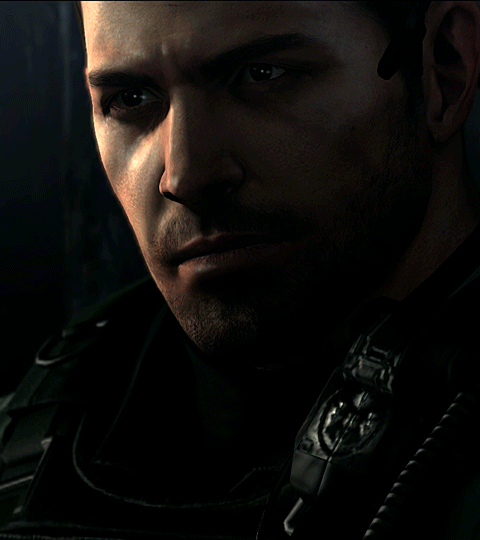
Aircraft Carrier – Below Deck/Command level
Your head is still spinning, but your body remembers what it means to fight.
You push yourself upright from the med bay cot, wincing as your ribs protest. Your shoulder burns, your temple throbs, but none of it matters, not with everything still unfinished.
Chris watches you from where he’s standing, jaw clenched tight. “You should be resting.”
You ignored that. “Ada’s still on this ship.”
“She is,” Piers says, grabbing his rifle and slinging it over his shoulder. “And from the looks of it, she doesn’t plan on going quietly.”
You stand, a little unsteady but determined. Your fingers curl around your weapon, the cold metal grounding you.
Chris’s gaze lingers longer than usual. Not just to assess your condition. It’s like he’s trying to remember who you are, what you are to him. You catch the hesitation in his eyes, the flicker of something just beneath the surface.
He doesn’t say anything.
He doesn’t have to.
Aircraft Carrier – Moving Toward the Command Room
The ship creaks and groans beneath your boots, metal warping with every distant explosion above deck. Red warning lights pulse along the walls. The storm outside makes everything feel like it’s shaking, but the real threat is waiting deeper inside.
The three of you move through the corridors, weapons raised. The tension is thick, familiar.
Just like Edonia.
Except this time, you’re not hunting a virus. You’re hunting her.
You step into the command corridor and stop dead.
A massive security blast door looms in front of you, flanked by two heavily armed drones perched like mechanical spiders. Their red targeting sensors flicker. Watching.
Chris raises a hand, signalling for silence.
Then…. *Click*
The drones activate.
Gunfire erupts, bullets pinging off the walls as one drone strafes left, the other launches into the air.
You dive into cover, heart pounding. Landing hard against a bulkhead. Your shoulder screams in protest, but you keep firing.
Chris grits his teeth and advances between volleys, tossing a grenade. The drone explodes in a rain of sparks and twisted metal.
Piers slides beside you, pulls out his rifle. “Get me a clear line of sight, I’ll take the second one out!”
You kick over a crate, using it for elevation. The drone skims past, *BAM*. Piers fires. Direct hit.
The corridor goes silent again. The only sound is the ship’s groaning and your own ragged breaths.
Chris steps up to the door. “She’s close.”
Command Room Breach
The security door creaks open.
You step through, rifle raised, and there she is.
Ada Wong. Standing on the upper platform, calm and composed like she’s not at the centre of the storm.
She turns, red lips curling into a half-smile. “Chris. You’re persistent. I’ll give you that.”
Chris takes a step forward. “We’re ending this.”
Ada tilts her head, gaze flicking to you. “Oh? And she’s still following you around, even now? How sentimental.”
You clench your jaw. She knows. Of course she does.
She always knew how to twist the knife.
A console nearby beeps.
Too late.
You hear the whirring of machinery before you feel it, a blast of air, then gas flooding the chamber. Another trap. You stagger back, coughing as it fills the room.
“Trap door!” Piers shouts.
You barely have time to react before the floor collapses beneath you.
Aircraft Carrier – Maintenance Levels
You land hard on a grated walkway, the sound of metal against metal echoing up the shaft.
Chris is already getting to his feet, checking to make sure you and Piers are okay, you groan and pull yourself upright. “she’s trying to slow us down.”
Chris doesn’t answer. His focus is razor-sharp now, eyes ahead as he scans the walkway.
“She’s moving to the upper decks,” Piers says, pointing at a security camera feed on the wall panel. “We cut through engineering, we can intercept her.”
Chris looks at you. “Can you keep going?”
“I’m not leaving your side.”
That makes something in his expression flicker. Something old. Something real.
“Let’s move.”
Aircraft Carrier – Upper Level Pursuit
The three of you charge through the winding corridors, the ship shaking around you from internal damage. Smoke pours from vents. Electrical panels spark.
More drones drop from the ceiling.
You and Chris cover Piers as he sets up a temporary barrier. The team moves in sync, no hesitation. No wasted movement.
Like muscle memory.
You’re fighting through a corridor when it happens.
Chris grabs your arm, pulls you out of the way just as a drone explodes against a doorframe. His grip is tight. Protective. Familiar.
He holds you for just a beat longer than he should.
You both feel it.
Then….
“Come on,” he says, breathless. “She’s getting away.”
Aircraft Carrier – Helicopter Launch Pad
You burst through the final door onto the open helipad. Rain pounds the steel floor. Floodlights cut through the downpour. The storm is in full foce.
And Ada’d already there.
She stands by the waiting helicopter, coat billowing behind her, every inch the ghost you’ve been chasing.
Chris steps forward, rifle aimed. “End of the line.”
“You really believe that?” she replies, voice smooth as ever. “After everything I’ve done, you still think you can stop me?”
You move to flank her, aiming down your sights.
Piers sets up position on her far side, weapon ready.
Ada sighs. “You just can’t let go of the past, can you?”
Chris’s jaw clenches. “You took everything from me.”
“Not everything,” she says, and her eyes flick to you. “Not yet.”
Then she tosses a smoke grenade.
You cough, trying to keep sight, but she’s fast, already climbing onto the chopper skid.
Chris rushes forward. You follow him without thinking.
“ADA!” he roars.
She looks down at him as the chopper begins to lift, wind whipping around all of you. “Better luck next time, Captain.”
Then she vanishes into the storm.
Chris stands in the rain, unmoving. Soaked. Breathing hard.
And completely still.
You approach slowly. “Chris-“
“I had her,” he mutters. “I had her.”
You reach for his hand. He doesn’t pull away.
“we’ll get her,” you say, soft but steady. “We finish this. Together.”
He finally. Looks at you.
And for a second…. You see it.
The old Chris. Your Chris.
The one who looked at you like you meant something.
The moment passes, but the weight of it stays.
#chris redfield#resident evil#chris redfield x reader#chris redfield resident evil#resident evil 6#chris redfield x you#chris redfield imagine#daddy chris redfield#re6#re6 chris#resident evil fanfiction#resident evil chris#resident evil 5#chris redfield fic#re1#re1999#re1 remake#re1 chris#re5 chris#re5#resident evil 1#re6 piers#re8 chris redfield#re8 village#re8#resident evil village#resident evil 8#re vendetta#resident evil vendetta#vendetta chris
15 notes
·
View notes
Text
Eschaton M-386 Black Box Footage
[Footage and comms audio recorded from the black box of an Eschaton Kaiju-Monitoring Air Vehicle. Crew identified as Callsigns Argos (he/they), Bruno (he/him), and Restless (she/her).]
[From the beginning of the recording, it's clear the ship is moving far too quickly, and far too low. Even considering the size of the megaflora on the planet, an aircraft should not be so low, so close to the base of the tree trunks. Especially not at night. It flies past roots and low-hanging branches as if it were a bullet train.]
Restless: Shit shit SHIT. Bruno, FIX IT!
Bruno: Oh, I'll just turn the damned engine off mid-air, will I?
Argos: Shut the HELL UP! Both of you! I can't bring us down if I can't fuckin' concentrate!
Restless: WHY are you bringing us DOWN?!
Argos: BECAUSE SHE WON'T PULL BACK UP, RESTLESS!
Restless: I KNEW brass should've had this rust bucket decommissioned.
Bruno: Don't talk about her like that!
Argos: SHUT THE FUCK UP!
[The craft rattles and jerks in turbulence as it loses altitude, twisting through the air like an arrow with torn fletching. As it begins to touch down it skids like a train screeching to a halt. Dirt and smoke are exhumed as the surface of the planet is ripped open in a burning streak. The sound of the crash devours the screams of the crew. They might as well be screaming in the void of space.]
[The trio are tossed like rag-dolls, forward and back, until finally the craft slows and grinds to a stop. By the end, one seat is practically through the control panel. Nothing inside is as it should be. It is as if it is a house ravaged by an earthquake. And there is more than a little blood. One with a subjectivity-enhancement suite would smell the iron of the stuff, twisting together with mud, oil, and smoke to choke the life from the air.]
Argos: Status! STATUS!?
[Restless lifts her head, dark curls splotched and flecked with red. Bruno does not move.]
Restless: Fuck. Ow. OW. He's out cold. It looks b-bad.
Argos: At least we're al- RA! Restless, your fucking arm!
[Her shoulder is very clearly dislocated. Her arm hangs limply to her side.]
Restless: Never mind my arm! We're so dead!
[The voices are shrill and desperate, and hoarse from screaming.]
Argos: Don't sa-
Restless: We're on the GROUND, Argos. With THEM! Are... are the sensors online?
[Her eyes are wild and desperate, practically bulging from her head. Argos tries to hide the same of their own. They fail in this.]
Argos: Lemme see. Fuck. FUCK. WHERE are the Jaegers???
[Suddenly, there's a thump from behind and to the right of the ship. Another. Another. The tremors are heavy enough to be felt through it, only just. A slow, methodical, almost curious trail of footsteps leading around the side of the vessel.]
[The conscious crew members turn silently to look to one another. Words need not be spoken. They share the same expression. That of cornered prey. Ever widening eyes and trembling lips.]
[The kaiju enters the frame of the remaining sensors: those near the front of the vessel. It's too close for the pilots to make out more than a skin of tawny scales stretched over a long, lithe, muscular body.]
[There is a baleful scratching at the roof of the craft. An angry creaking that becomes an impact. The ship rocks violently. Again. Again, harder this time. The rocking is accompanied by a low, echoing rumble. The vocal cords of a haunting giant, rattling its prey's bones.]
Restless: no...
[Creaaak. BANG. BANG.]
Restless and Argos: NO NO NO NO NO-
[Their voices are that of mice. A desperate squealing and squeaking for escape is all that can be compared to their horrified screams. By now tears and snot trail the young woman's face. Her elder can do little more to hide his state.]
[About a hundred meters ahead, a form slips just close enough to be made out in the dim, flickering light cast by the aircraft. The same scales adorn its hide, and while the lighting conditions obscure the details, it casts a silhouette before the crew. Some twisted and elongated hybrid between a lizard and a hound. Four hateful pinpricks for eyes burn from its skull, and they grow closer as the second beast takes a step forward.]
Restless: A-Aargos?
Argos: I-I dunno. I dunno. I don't. Fuck.
[BANG. BANG.]
[The roof begins to buckle, predator's claws tearing at steel to bend and warp it in inwards. The crew's shrieks drown out that of the metal this time.]
Restless: Ar- *sniff* A-Argos...
Argos: I-I know, Res, I k-know. I-
[sKRREEEEAAK]
[The metal is finally punctured. A line is slowly, agonizingly shredded into the roof by a single, lucky talon.]
Restless: AAAHH!! AAAAAAHH!!!
[The youngest of the crew throws herself to the floor of the ship in an attempt to gain any possible distance from the creature. Her cries continue as she curls down, covering her head with her good arm, for whatever small help that will be.]
[For a moment, Argos is paralyzed in fear. But the cries quickly shake them back to reality. They scramble from the pilot seat to shove themself between their crew and the beast. Whatever desperate obstacle they can become for the thing to approach the unconscious and the newbie, they will.]
[This continues for what feels like forever. That claw rips open a tear large enough for four crimson pinpricks to stare through. Argos stares back, unwavering even as heavy beads of sweat roll down their dark features. Even as his entire body quivers, trembles.]
Argos: S-Stay back. STAY AWAY FROM MY CREW.
[There is a moaning rumble in response, almost as close to a trumpet as an animal. For a moment, it looks as if the creature will reach more claws into the ceiling and pull the ship apart for the delicious morsels inside. But its head turns to react. Argos turns to look at it, too. This new, dim light washing across their face. A crimson-violet glow. Such a hateful, pained light.]
[The second creature doesn't have the luxury of slowly turning like the first and Argos. From the forward sensors, it is seen being torn backwards, further into that glow. Pulled violently by its tail, it's dragged from its feet until the source of the light looms overhead.]
Argos: Is t-that. Fuck, is that HER?
[Restless' head finds its way back up. Her eyes are puffy and red.]
Restless: Her?
[Argos' next words still carry fear, but there's chuckle. The kind that comes to one in a state of pure disbelief.]
Argos: The off-worlder...
[The second kaiju snaps back at its assailant, only to have its head slammed down into the mud by a massive, metal paw.]
[The paw itself is attached to an enormous pantheran machine. A powerful feline of steel and slag. Its eyeless face drags outward into a snout lined with white-hot razors for teeth. Past its fearsome jaws and down its throat, the wicked muzzle of a rifle protrudes. Snaking down its neck and all along its powerful body, burning, hatefully glowing tubes produce that eerie magenta light, until they come to an end at each wretched claw. The tubes push between armored plates and reinforced servos, taut against the body except for a spot on the back, where some swish back and forth slowly and playfully, like the twin tails of a cat that's crawled out of hell itself.]
Argos: Nemean!
[As the beast struggles under the arm of the larger mech, biting and thrashing and screeching, the mechanical lion lifts its second, equally terrible front paw. From its back haunches it throws its bodyweight onto the kaiju through that paw, a jagged spike extending from the same wrist. The spike is driven straight through the kaiju's scaled back thigh and into the deep, muddy earth as it wails in agony.]
[The ship shakes violently as the beast which was menacing it throws itself back to all fours. In a challenge against this new adversary it roars an awful, hornlike roar. The mic clips as the vessel vibrates, and the crew cover their ears with their hands in a desperate attempt to protect their fragile, person-scale eardrums.]
[As it breaks the spike from its wrist off in the further kaiju, letting the thing squirm and writhe as its blood paints the Prosperan soil, the armored lion drops to all fours. From there, it issues its response. A line of spines? No. Small, external reactors along its back, only visible now from its new posture, flare with light, and the thing roars.]
[It's louder than the kaiju. From external speakers somewhere on this thing's body, the noise spills forth. Higher pitched than one would have thought, but crackling. Raspy. Raw fury. Hate given voice. A scream from the deepest pit of any faith's underworld. The inflection, the resonance is feminine, but it can't be from the throat of a woman. A human couldn't make that sound. Surely not.]
[The kaiju darts forward from the side of the wreck and towards its pack-mate's attacker. It moves swiftly, gracefully. Like a monitor lizard moves through water, it moves upon the ground. Yet no amount of grace could prepare it.]
[The horrid, burning claws snake outward along those white hot tubes. Like so many whips, they crack through the air in a trail of light and sparks and rip across the monster in its approach. The scaled creature is thrown from its momentum and lands on its side, stunned at the speed with which a new set of stripes is seared into its now smoking flesh. By the time it knows to roar in pain, the claws have slipped back to a reasonable length.]
[The beast's agony gives the machine lion the time it requires to descend back onto its first target. The reptile's maw closes around its arm, crunching metal and servo beneath its own impressive weaponry. The mech ignores this final defiance.]
[The jaws of the lion clasp onto the pinned beast's neck. It begins screeching and squealing in agony as the teeth burn. Sear. Pierce. Crunch. MELT. Desperate struggling and tearing fills the ears as charring flesh and liquid copper fills the nostrils. The smaller monster howls a final plea just before a deafening SNAP.]
[As the other reptile recovers from its writhing caused by the virulent talons, it scurries back the way it came. Stumbling and slamming into the wreck, it attempts to slide its way past.]
[The machine lion notices this and, lifting its now gore-wet snout from its prey, bounds after the beast with speed unnatural for its indomitable size. The very earth shakes as it pounces out of frame.]
[In mere moments, the remaining kaiju can be heard wailing from alongside the ship, which rocks and rattles as a pair of monsters wrestle only a few paces away.]
[The smaller of the beast screams in fury and pain. In fear and despair. The tearing of flesh only grows louder. The snapping of bones, even the popping of vertebrae.]
Restless: Oh RA. Oh I'm gonna be s-sick
Argos: Just be glad it isn't us.
[Despite saying this, he gags halfway through the sentence.]
[Over the next few minutes of the recording, the crew reorient themselves. After taking a moment to breathe and steady their trembling forms, first aid is applied. Bruno is stabilized. Restless yips in pain as Argos shoves her shoulder back into its socket.]
[All the while, their attacker's agonized cries grow softer and softer, before dying out completely. All the while, the unfiltered scent of gore grows ever stronger. All the while, flesh and bones are torn and snapped just outside. It is a sickening, violent thing. But it is a sickening, violent thing which somehow settles into a comfort. A horror to guard them from other horrors.]
[Eventually, the engines of an Eschaton rescue vehicle are heard overhead. The recording ends not long after.]
#lancer rp#lancer enkidu#lancer rp blog#lancer ttrpg#sally screaming#cw blood#cw: gore#cw violence#cw gagging#short story#my writing
8 notes
·
View notes
Note


Can you rate this glorious product of the genius of Mike Sparks, the Areo-Gavin?
I.... made the mistake of going onto Mike Spark's website to research this farce.
Please, do not make my mistake, the Aero-Gavin isn't even the most delusional thing ON ITS OWN PAGE.
Most of what I say here will be echos of what LazerPig put in his own video.
So, for those not in the know the "Aero-Gavin" is the attempted revival of the hundred-year-old "flying tanks" idea by reformer and conspiracy-nut, Mike Sparks, using his personal favorite fetish object the M113 (he calls it the "Gavin") shoehorned into the role of an IFV.
We're going to start with the wings, they're biplane wings. This is because the cover of the Popular Mechanics magazine he ripped the idea from had biplane wings, the engine is in the same position as well. I'm not an aircraft expert, but there's a reason biplanes went out of style in the late 1930's. Even If you do manage to get this twelve ton brick that only a moron would think is capable of flight in the air, you still have to fly it.

This is the driver's position in the M113,

This is the cockpit of the Piper Cub, a small single engine aircraft.
As you can see, there is a VERY big difference. The cub has a large windscreen with equally large windows of both sides. The M113 has four small periscopes that don't even give you a 180-degree field of view. How the hell is any one supposed to fly this brick? Stick your head out the diver's hatch in mid air? And do you see all the instrumentation the Piper has? That'll all need to be crammed in the Aero-Gavin too, but that won't be enough, it needs GPS and radio encryption equipment too! And you see those two missiles on the top of the wings?, those are AIM-9 Sidewinders, you'll need some equipment for those too! Did you know that when the Aero-Gavin lands, it discards its wings? ALONG WITH A MILLION DOLLARS IN CLASSIFIED MUNITIONS, GEE I'M SURE NO-ONE WILL COME ALONG AND STEAL ALL OF IT!!
You know, the guy that flies this hundred-year-old idiot trap is going to have to be at-least a sergeant because of all the extra training they'll need. It's a higher rank than Mike Sparks ever could have fairly achieved.
Mike says on the page that the Aero-Gavin takes to the skies to avoid Precision Guided Missiles, things like ATGMs and guided artillery.
SO IT FLIES! And gets targeted buy MANPADS, SAMs, AAMs, Heavy Machineguns, Autocannons, and still (as the Ukrainian Army has proven) ATGMs.
But..... I could fix this.
What if we gave it rotatory wings instead?
What if we made it hover, so it wouldn't have to land to deploy its troops?
What if we moved the single rear door to both sides, to make room for a fixed tail boom?
What if we turned the top gunner's position into a pair of side gunners?
What if we gave it a panoramic glass cockpit with modern avionics, communications and sensor equipment?
What if we replaced the Sidewinders with Stingers?
What is we gave it rocket pods?
What if it could carry Hellfires?
WHAT IF IT WAS ALREADY IN SERVICE WITH MULTIPLE MILITARIES AROUND THE WORLD?!
Y'all it's the Blackhawk.





(sorry for stealing your joke LazerPig)
FINAL SCORES
Credibility: 1/10 - 3 year old’s Crayon Drawing
Coolness: 1/10 - Ugly as Sin
BONUS
Here's that LazerPig video I mentioned earlier
youtube
Mike Sparks, if you see this, you are a delusional idiot with fewer IQ points than an inbred tortoise.
37 notes
·
View notes
Text
took another crack at an Illegal Design in the ol' word doc, and this time, it's how I imagine some MechTech tries to make sense of the Dark One
Name: Marauder (MAD-DRK) Tonnage: 75 (Heavy) Role: Killingyouguy Year: 2666 Tech Base: Clan (Mixed) Tech Level: Experimental Base Type: Standard biped Design Quirks:
Positive: Animalistic Appearance, Anti-Aircraft Targeting, Barrel Fists, Command ‘Mech, Cowl, Directional Torso Mount (RT C-LPL), Distracting, Easy to Pilot, Extended Torso Twist, Fine Manipulators, Hyper-Extending Actuators, Improved Sensors, Improved Targeting (all ranges), Narrow/Low Profile, Multi-Trac, Protected Actuators, Searchlight, Vestigial Hands
Negative: Illegal Design, Obsolete (2666), Difficult to Maintain, Non-Standard Parts, Oversized
C-Bill cost: you don’t “buy” a Black Marauder BV cost: it doesn’t TONNAGE:
Structure: 4t
Engine: 19t
Cockpit: 4t
Heatsinks: 15t
Armor: 12t
Jump Jets: 4t
Equipment: 21t
INTERNAL STRUCTURE: you don’t want to know, but this is what MechTechs think is going on (with notes by other MechTechs saying "no the fuck it's not")
HEAD:
Life Support (none, actually)
Sensors (maybe?)
Interface Cockpit (laughable, this idea; the damn thing probably has a brain)
Sensors (again, possibly)
Life Support (HA!)
SLDF Triple-Strength Myomer (?)
Chameleon Light Polarization Shield (?)
Null-Signature System (?)
Self-Repair Gel (?)
CENTER TORSO:
Engine (presumably): Six crit slots
Clan Double Heat Sinks (2)
ECM Suite
SLDF Triple-Strength Myomer (?)
Chameleon Light Polarization Shield (?)
Null-Signature System (?)
Self-Repair Gel (?)
Supercharger (?)
LEFT TORSO:
SLDF Triple-Strength Myomer (?)
Chameleon Light Polarization Shield (?)
Null-Signature System (?)
Self-Repair Gel (?)
Jump Jet
Jump Jet
Clan Large Pulse Laser
Clan Double Heat Sinks (2)
Endo Steel (3)
Ferro-Fibrous (2)
RIGHT TORSO:
SLDF Triple-Strength Myomer (?)
Chameleon Light Polarization Shield (?)
Null-Signature System (?)
Self-Repair Gel (?)
Clan MASC (?)
Jump Jet
Jump Jet
Clan Double Heat Sinks (3)
Endo-Steel (2)
Ferro-Fibrous (3)
LEFT ARM:
Shoulder
Upper Arm
Lower Arm
SLDF Triple-Strength Myomer (?)
Chameleon Light Polarization Shield (?)
Null-Signature System (?)
Self-Repair Gel (?)
ER PPC
ER Medium Laser
Clan Double Heat Sinks (2)
Endo Steel (1)
Ferro Fibrous (1)
LEFT LEG:
Hip
Upper Leg
Lower Leg
Foot
SLDF Triple-Strength Myomer (?)
Chameleon Light Polarization Shield (?)
Null-Signature System (?)
Self-Repair Gel (?)
Clan Double Heat Sink
RIGHT ARM:
Shoulder
Upper Arm
Lower Arm
SLDF Triple-Strength Myomer (?)
Chameleon Light Polarization Shield (?)
Null-Signature System (?)
Self-Repair Gel (?)
ER PPC
ER Medium Laser
Clan Double Heat Sinks (2)
Endo Steel (1)
Ferro Fibrous (1)
RIGHT LEG:
Hip
Upper Leg
Lower Leg
Foot
SLDF Triple-Strength Myomer (?)
Chameleon Light Polarization Shield (?)
Null-Signature System (?)
Self-Repair Gel (?)
Clan Double Heat Sink
#battletech#i need you to know this entire internal structure diagram is meant to be total BS#and yes it's over-tonnage#and it's clantech before the clans even existed#and it has both MASC and TSM listed#and it has negative crit slots left by a lot#as I said: total BS
5 notes
·
View notes
Text
F-14 Tomcat Variants
A beginner’s guide to identifying and differentiating the different F-14 Tomcat variants using three distinctive, easy-to-spot features: Glove Vanes, Engine Exhaust Nozzle (aka “Turkey Feathers”), and Sensor Pods.
F-14A
NUMBER BUILT: 637 total
INTRODUCED: 22 September 1974
The F-14A’s were the first Tomcats ever produced. The TF30 engines were initially an interim engine used during testing but it was later decided they would be used in full production of the F-14A. A total of 478 F-14As were delivered to the US Navy and 79 were delivered to Iran with the TF30-P-412A engine. Iran was supposed to receive 80 aircraft but the last one was given to the US Navy. Later in production, the final 102 F-14A’s were delivered to the US Navy with Pratt & Whitney TF30-P-414A engine.
IDENTIFYING FEATURES:
✅ GLOVE VANES
The A-variant is the only variant of the Tomcat to have Glove Vanes. They were designed to automatically deploy when the aircraft was flying at speeds greater than Mach 1.4 and retract when below in order to correct the tendency for the Tomcat’s nose to pitch downwards at high speeds. They were notoriously difficult to maintain and the benefit was marginal at the speed they were designed for, so the glove vanes were disconnected entirely and welted shut. The glove vanes were not featured on new F-14 Tomcats, but the outline of the glove vane makes it easy to identify an F-14A or an F-14B/F-14D that was a rebuilt F-14A.
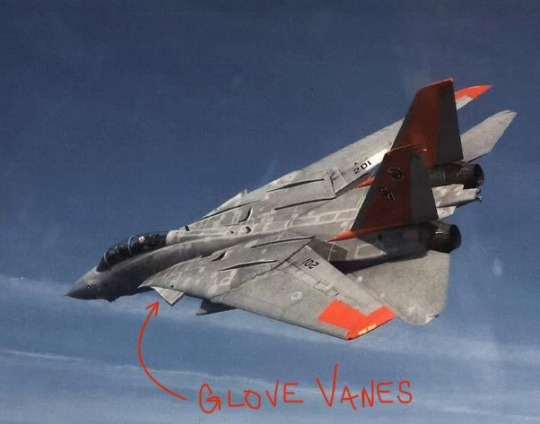
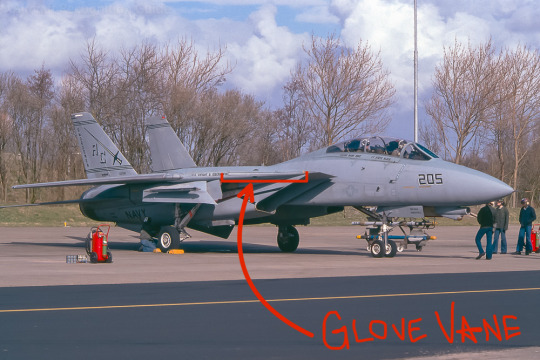
✅ SMALL NOZZLE EXHAUST FEATHERS
When compared to the F110 engines, it becomes pretty easy to tell the difference. When you look at the TF30 engine nozzle, you’ll see a lot of small metal plates, “Turkey Feathers,” that expand and contract when the nozzle opens and closes. It’ll be easier to tell the difference once you take a look at the General Electric F110 engine used on later F-14 Tomcat variants. This is the BEST way to identify an F-14A.
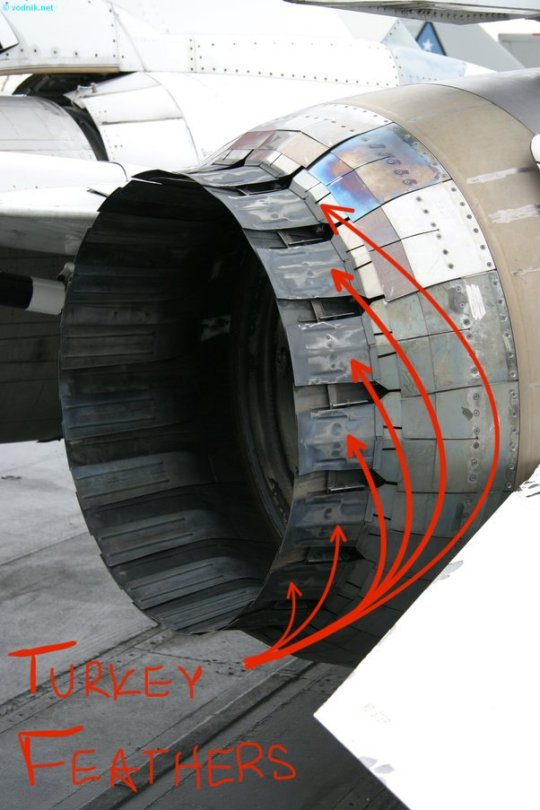
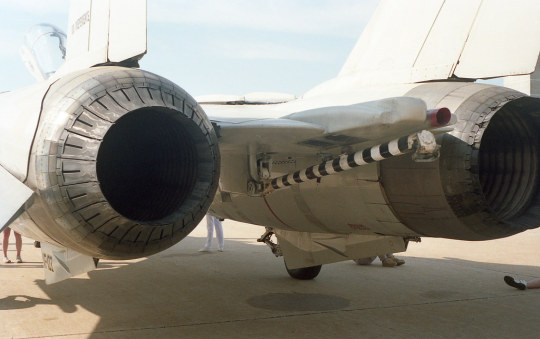
✅ SINGLE SENSOR POD BELOW CHIN
I recommend using the TF30 engine as the best way to identify an A-variant Tomcat as they are the only variant with those engines, however, I am choosing to include a section on the sensor pods for your reference as it is important for identifying the B and D-variants. The F-14A features a single sensor pod located below its chin but can come in a variety of configurations.
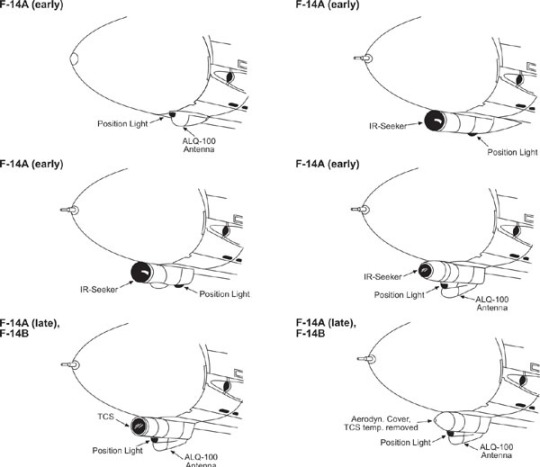
F-14A+ aka F-14B
NUMBER BUILT: 81 Aircraft (38 new builds, 43 upgraded F-14As)
UPGRADES BEGAN: March 1987
Initially designated the F-14A+, the upgrade is primarily characterized by the replacement of the Pratt & Whitney TF-30 engine with the General Electric F110-GE-400 engine due to being notoriously problematic. Many of the avionic systems and radars were retained, but the ALR-67 Radar Homing and Warning system was added. The A+was redesignated to the F-14B on 1 May 1891.
In the late 1990’s, the F-14Bs were upgraded again to extend its airframe life and upgrade the avionics system, but it was not given a variant designation due to the lack of major changes.
MAIN VARIANT FEATURES:
F110-GE-400 engines
ALR-67 Radar Homing and Warning system
IDENTIFYING FEATURES:
❌ NO GLOVE VANES
As stated in the section for the A-variant, the glove vanes were welded shut and completely disconnected on all existing Tomcats. On new builds, they weren’t even included in the design, however, if the aircraft is an upgraded F-14A, you might see the glove vane outline. This would be a way you can identify which aircraft were originally F-14As (Rebuild) and which were completely new builds.
✅ LARGE EXHAUST NOZZLE FEATHERS
Because most of the F-14B models were upgraded F-14As, it’s a little tricky to tell the difference sometimes. The easiest way is the F110 engine nozzle’s large turkey feathers. In comparison, the turkey feathers on the F110 engine are significantly larger and fewer in number, making it easily identifiable.
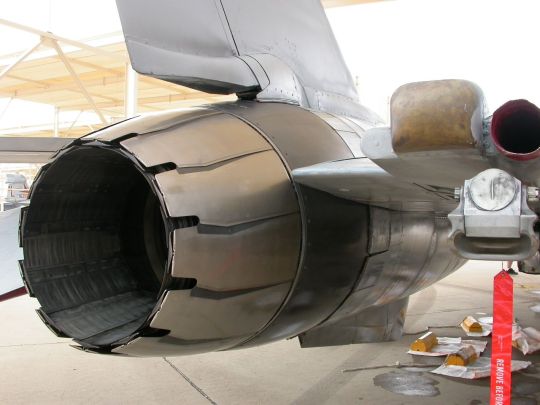
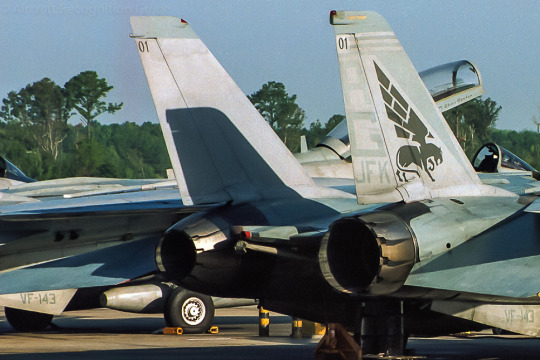
✅ SINGLE SENSOR POD BELOW CHIN
If you see a Tomcat with guide vanes and the F110 engine, then you can infer that it isn’t an F-14A. But to tell the difference between an F-14B and an F-14D, you’ll need to examine the sensors located below the chin.
Similar to the A-variant, the F-14B only has a single sensor pod located below its nose. The B model only had one true configuration with the Tactical Camera System (TCS), however, it may have an Aerodynamic Cover. This image from M.A.T.S. best shows the only possible sensor pod configurations for the F-14 A and B. The bottom two diagrams represent the B-variant.

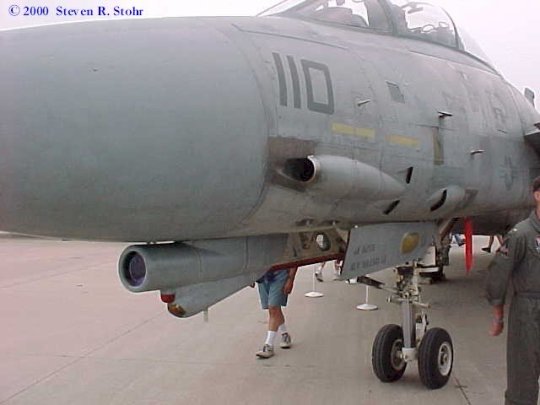
F-14D Super Tomcat
NUMBER BUILT: 55 aircraft (37 new, 18 upgraded F-14As)
UPGRADES BEGAN: 1991
The F-14D, much like the F-14B, featured many avionics upgrades, including a new AN/APG-71 radar radar to replace the AWG-9 used in the A and B-variants and digital avionics systems. The D-variant, also called the Super Tomcat, featured the same F110-GE-400 engine used on the B-variant. There were many other upgrades to the F-14 Tomcat’s systems in this variant.
MAIN VARIANT FEATURES:
F110-GE-400 engine
AN/APG-71 radar
Glass cockpit
IDENTIFYING FEATURES:
❌ NO GLOVE VANES
As stated in the section for the A-variant and the B-variant, the glove vanes were welded shut and completely disconnected on all existing Tomcats. On new builds, however, they weren’t even included in the design. The rebuilds, however, might have the glove vanes if they were not removed during the rebuild process. F-14Ds upgraded from F-14As may also be designated F-14D(R)s, where R stands for rebuild.
✅ LARGE NOZZLE EHAUST FEATHERS
Many of the F-14Ds were rebuilt F-14As, so it’s a little tricky to tell the difference sometimes. The easiest way, similar to the F-14B, is the F110 engine nozzle’s large turkey feathers. In comparison to the TF30 engine, the turkey feathers are significantly larger and fewer in number.
✅ TWO SENSOR PODS BELOW CHIN
The main differentiating feature between the F-14B and D variants is the sensor pods located below the chin of the aircraft. This variant features two sensor pods as opposed to the one sensor pod of previous variants. This allows the aircraft to have both the Infra-Red Seeker pod and the Tactical Camera System (TCS). The F-14D is the only variant to have both, making it the easiest way to distinguish it from other variants.


#SOURCE: HOME OF M.A.T.S. Most comprehensive F-14 Tomcat website#SOURCE: Aircraft Recognition Guide#<- they got some stuff wrong tho i think#F-14 Tomcat#Reference#F-14 Tomcat Variants#Guide#F-14A#F-14D#F-14B#terminology#glove vanes#i like planes#airplane research#research#airplane history!#info#information#Turkey Feathers#idk what other tags to add lol#Navy#Top Gun#Top Gun Maverick#If you want me to make a post about something specific let me know#I like to analyze and research#just a little thing I wrote
68 notes
·
View notes
Text

Scythe Model: Arrowhead
An interceptor-fighter craft known for its speed and unique style of combat that had made it the bane of all Imperial attempts at air superiority. The Arrowhead Model is specialized for Aeronautics combat, while its much larger and heavily armed variant, the Viper, is specifically constructed as an orbital fighter.
General Design:
Shaped like a leaf, the Arrowhead is quite small for an aircraft, not even nine meters long, with a width of three meters, its small profile makes it a challenge to target, especially when its right up in your face about its deadly intentions. Yet its proportions hide a surprisingly sturdy frame, on top of having a passive sensor mask that makes it very challenging for standard targeting equipment to get a lock on it or detect their approach until they are almost on top of its target.
Propulsion and Manoeuvrability:
The Arrowhead Scythe is propelled by six thruster engines at its caudal side that are not too dissimilar to the design of the plasma thrusters on void ships, if only with a much smaller profile. Furthermore, it is aided by grav-plates to remain suspended in the air without the need of wings to support its flight. However, these are not the most outstanding features of this craft, those would have to be the Gyroscopes.
Mechanicum adepts are still in heated debates as to the inner workings of recovered pieces of the Gyroscopes, as they have been dubbed, from dead Arrowhead craft. But what they all agree upon its that they are the singular most fundamental piece in the Arrowhead’s near physics defying agility.
Named after the device they most closely resemble in appearance; it is theorized they emit some form of gravitational anchor point that allows the craft to always be relative in their positioning to the closest primary gravitational well.
This is how the Arrowhead is able to remain in stable flight and turn without the need of any form of wings, as well as perform manoeuvres that would otherwise kill an organic pilot within. For instance, by simply rotating both Gyroscopes inside the Arrowhead in the same direction along a horizontal plane, the craft immediately spins on its axis without changing direction, allowing it to suddenly turn around on a pursuing target and light it up with its main armament before reconfiguring its trajectory back into a stable flight configuration.
For this reason alone, the Arrowhead has earned the righteous ire and fear of all Imperial pilots who have ever faced them in battle and survived to tell the tale.
Weaponry:
Arrowheads are a significant threat to face in combat, made all the deadlier by their arsenal.
Primary Weapon: Arrowheads maintain their weapons locked beneath their plating when in cruising mode or whenever they are performing their most famous attack. Depending on the Sub-Model of the Arrowhead, one could either expect forward facing twin linked las-cannons with surprisingly high rates of fire or a missile volley, ranging up to ten fire-and-forget missiles before the craft needs to fabricate replacements.
Secondary Weapon: Arrowhead Scythes all tend to be fitted with a secondary weapon on its underside, usually geared for smaller targets like infantry. These weapons tend to vary greatly from direct energy weapons like Laser Beamers and Volkites, or kinetic weapons such as RCGs.
Power Field Blade Wreathe: The most famous weapon of the Arrowhead, even if it’s the one with least range, if only due to the sheer gal of the Men of Iron to create a fighter craft specialized for melee.
Given its sturdy design and high manoeuvrability, the Arrowhead is designed to ram against enemy aircraft to immediately achieve a kill or shatter formations, forcing a chaotic dogfight where the Arrowhead holds the advantage or is actively forcing enemy craft to focus on it while other aircraft deal the finishing blow.
This final armament converts the Scythe into a flying Power Blade capable of slicing clean through a Lightning Strike Craft without hardly loosing speed, and given its agility, entering close quarters combat with these crafts is always a deadly dance where one wrong move could result in a swift end by the reaper’s blade.
#digital art#digital drawing#artists on tumblr#my art#art#pixelart#drawing#pixel art#pixel illustration#concept art#weapon design#sci fi#scifiart#aircraft#fighter plane
11 notes
·
View notes
Note
Question: the autopilot kicked out because … the airflow coming into the plane was more than the autopilot could compensate for? And then once Athena and Jim fixed it, the autopilot must have come back on?
Because I don’t really understand how any of that works, but I did notice that Athena leaves to cockpit and tries CPR on the copilot, so I suppose they just didn’t mention autopilot came back? I was a little confused about how this happened.
It’s 9-1-1, the answer probably could be they were hoping no one would notice.
This is very hard to explain, because I'm just someone who likes planes a lot. I'm not a pilot, scientist or engineer, and this is an engineering question. I only know a tiny little bit how to operate an aircraft, I can't explain how a particular airframe works on a deeper level. I know there are actual scientists among my followers, so can someone help me out?
Anyway, I'll try. Just know that I'm in no way as knowledgeable as an actual professional.
So first, different models of airliners have different flight computer systems and aerodynamic characteristics. This one in 8x02 is not real. The cabin and the cockpit are emulating an Airbus 330, but in the show it's a "Skytrain 880", they intentionally avoid connecting the fictional crashing airplane to real life ones, in case some aviation big brass gets mad.
But in general, autopilot on a commercial airliner works like a fancy, more precise cruise control. It's a bit like a Tesla, you can use it to drive itself on an open, relatively straight highway, but you can't use it to make sudden turn into an exit or to swerve and dodge an obstacle ahead. Airplane autopilots are likewise designed for normal operations.
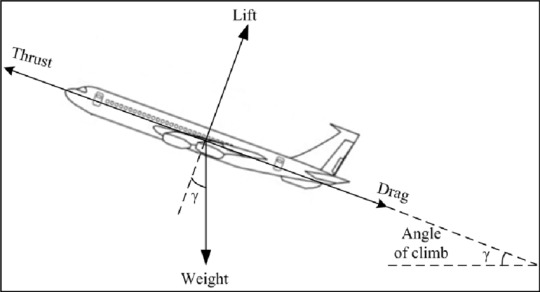
In the scene in question, the hole at the back of the plane suddenly opens up and the broken fuselage skin, the other debris sticking up in the air and the giant gaping hole create large amount of localized drag at that area. The thrust produced by the engines stops being able to counteract the additional drag, so the plane starts losing speed rapidly. A fixed wing aircraft generates lift by continuous airflow around the wings, so less air speed equals less lift, hence the sudden drop in altitude. In order for the plane to stay airborne and not crash into the nearest mountain, it needs more speed and it needs to climb. Airliner pilots are well trained to resolve this problem, but Athena has no prior experience in flying any plane, so the flight instructor on the ground has to come up with a solution easy enough to execute that even a total novice like Athena can understand.
The flight instructor thinks increasing air speed is the priority, so he asks Athena to simply slam the throttle to full thrust until optimal air speed is reached. Airplanes with engines mounted under the wings (hence under the center of gravity) has the tendency to pitch up when forward thrust is applied. (I don't know how to explain that, again, scientists/engineers please help me) So the flight instructor warns Athena that the plane will pitch up and climb pretty rapidly when she applies maximum thrust, but the autopilot should be able to understand that, and compensate with enough nose down pitch to keep the plane level, eventually.
The flight instructor probably underestimated how big of an impact the hole in the fuselage has to the overall aerodynamic properties of the plane. The autopilot is never designed to take such an extreme situation in to consideration, so it decides the math isn't mathing. I've tried my usual routine to level the plane but it isn't working, something is wrong, so pilot, you should take control of this one, in case my sensors are wrong. So the autopilot disconnects, and the pilot flying has to put in manual downward pitch to level the plane, which is exactly what the kid does.
If the airflow really is too strong for the elevator itself to pitch the plane down, any control input from the pilot wouldn't matter either. This is instead the case of autopilot being asked to do something out of the ordinary, so it disconnects itself in case of a computer error, and asks the pilot to make the input manually instead.
Once the plane returns to normal condition (aka level flight at the right speed), autopilot can be engaged again. The kid has probably already done that by the time Athena leaves the cockpit, we just didn't see it. Even if he didn't, he would still be in the pilot seat taking control of the side stick when Athena gets out.
#It's the first time I've typed the word thrust so many times when there's nothing smutty#I apologize for the word salad#I really don't know how to explain#ask answered#911 spoilers#911 meta#911 abc#athena grant#aviation realism
10 notes
·
View notes
Text




SR-71 #955 was the first SAC SR it was not 1965 designated for flight test only.
This is what my Dad Richard” Butch” Sheffield wrote down about the SR-71 program in 1965
On February 16, 1965, SAC Headquarters sent the message assigning the first six crewmembers to the SR-71 Program from the 43 BW, Little Rock, and 305 BW, Bunker Hill. The reporting date to 4200 Strategic Reconnaissance Wing (SRW), Beale, AFB, California, was not later than April 20, 1965. I was one of the six.
On April 30, 1965, Colonel Nelson and his wife hosted the first four SR-71 crews at the Officers Club for dinner. It was the first time the whole group had ever been together and had met each other and the wives. All of the wives were beautiful; in fact, Mrs. Nelson accused Colonel Nelson (jokingly) of picking us for the program because of our wives' beauty. We were all very aggressive and hardworking men and had married beautiful women.
Arrival Skunk Works May 1965
The next week we all left our families and drove to the “Skunk Works” (SW) in Burbank, California, to attend the first course ever taught about the SR-71. The course was for the pilots and Navigators and would last about six weeks. The Navigators would stay at the SW for several weeks longer to learn about the navigation and sensor systems.
Nortronics had developed a very accurate digital computer navigation system. The only problem was no one had told them how the SAC Navigators would use the Navigation Systems in flight. They had designed the system to work without inputs from the cockpit and we could not even change the flight path or read the time off of it in flight. All time readouts were in octal. We asked Nortronics Engineering to come see us and it was very carefully explained how we wanted the system to work.
Flying first sorties
My first flight in the SR was on October 13, 1965. The aircraft was number 955; I had seen it being built at the SW in May. My pilot was Pete Collins. This was the first time that two Captains had flown a SR. We did not wear pressure suits and only went to mach. 2. The checklist was two pages long.
When I left the Program eight years later, it was two inches thick.
I have my Dad‘s written down history, but I would love to hear from other pilots and navigators.
Linda Sheffield
My photos are from the Jim Goodall collection.
@Habubrats71 via X

#sr 71#sr71#sr 71 blackbird#blackbird#aircraft#usaf#lockheed aviation#skunkworks#aviation#mach3+#habu#reconnaissance#cold war aircraft
55 notes
·
View notes
Text

The F/A-18 Super Hornet is a versatile, carrier-based fighter and attack aircraft developed by Boeing for the United States Navy. It serves as the successor to the original F/A-18 Hornet and incorporates significant upgrades and enhancements in performance, range, and payload capabilities.
Introduced in the late 1990s, the Super Hornet was designed to address the evolving challenges of modern warfare, offering improved mission flexibility and endurance compared to its predecessor. It features a larger airframe, more powerful engines (General Electric F414), and advanced avionics systems.
One of the standout features of the F/A-18 Super Hornet is its ability to perform a wide range of missions, hence the designation "F/A" which stands for Fighter/Attack. It can conduct air superiority missions, ground attack, close air support, and reconnaissance missions with equal proficiency. This versatility is enhanced by its conformal fuel tanks and additional underwing hardpoints, allowing for increased fuel capacity and a greater payload of weapons and sensors.
The Super Hornet is equipped with the APG-79 AESA radar, which provides enhanced situational awareness and targeting capabilities. It also features advanced electronic warfare systems and the ability to network with other aircraft and ground units, contributing to its effectiveness in joint operations.
In combat, the F/A-18 Super Hornet is armed with a variety of air-to-air and air-to-ground weapons, including AIM-9 Sidewinder and AIM-120 AMRAAM missiles for air combat, and a range of precision-guided bombs, missiles, and rockets for ground attack missions.
Over the years, the Super Hornet has been continuously upgraded with new technologies to maintain its edge in modern aerial warfare. Variants such as the EA-18G Growler, which specializes in electronic warfare, further demonstrate its adaptability and role in supporting combat operations.
The F/A-18 Super Hornet has been widely exported and is operated by several other countries, further underscoring its reputation as a reliable and capable multirole fighter. Its ongoing service and adaptability ensure that it will remain a cornerstone of naval aviation for years to come.
106 notes
·
View notes
Note
🎫🎫 one for each of those robots ^-^
~ @botanists-little-cookie
!!!!yayyy thank you ^_^<3 OKAY SO OH MY GOSH PHOENNIIIXXXXX
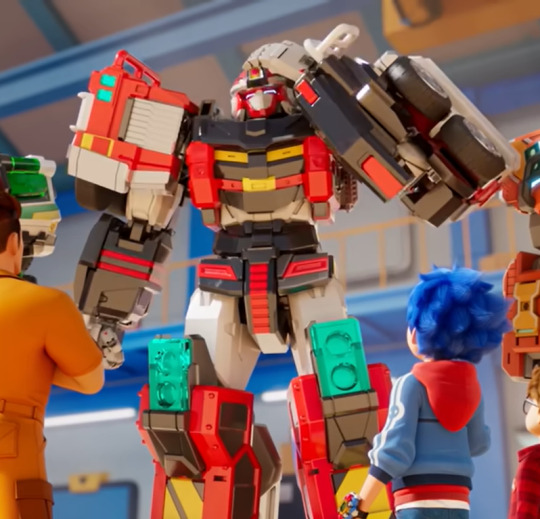
AHAHGHNGNBGFJHES OS FCKIN G CUTTEE....... Phoenix Fire is a fire truck/engine, back on planet Machina he was the top firefighter before their planet exploded(rip<//3) so when he and the other Cardbots(separately) came to Earth, Phoenix's spacecraft/escape pod started burning up in the atmosphere and as his ship crashed in the ocean it was completely engulphed in flames so he developed a massive fear of fire, putting out every fire he spotted, even the insignificant ones like a lit candle(his internal heat sensor got broken and was kicked into overdrive basically) and its.really horrible <:( at the end of his episode his sensor gets fixed, but he deals with his pyrophobia through the rest of the show and gets better with it <3 and like.LIKE HE DRIVES ME CRAZZYYYYGHGHHNMNNMKD HES SO SWEET AND STRONG AND I WANNA KISS HI9S CUTE FACE!!!!!!!!!!!! i definitely understand his fears and I want to help him overcome them <3 plus hes so understanding and respectful and ddsfghfhgvshfjggjygh Phoenix Fire is such a sweetieee auhgh i HAVE to cover him in kisses i dont even care that either of us dont have mouths(s/i is also a cardbot) im gonna nuzzle him forevefrand ever !!!!!!!!!!!!!!!!!!!!!! AND AND. SHADOW !!!!!!!!!!!!!!!!!AAHHEHEHE
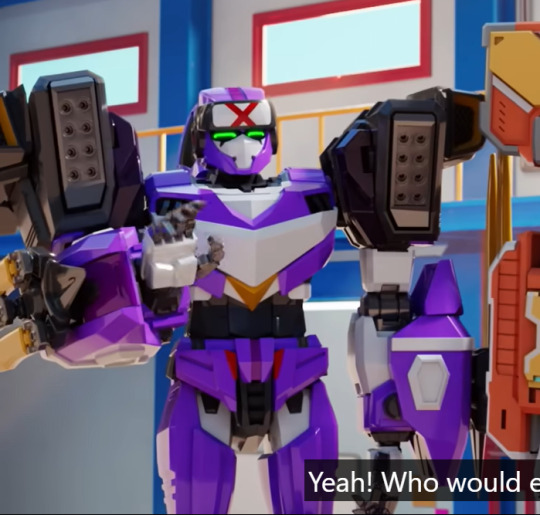
SHADOW MY SILLYPIE MY GOOFY GUY!!!!!!!!!!!!!!!!!!!!!!! EHEHGEHNE Shadow X is a VTOL aircraft(vertical takeoff and landing) who can turn invisible and he is a MASSIVE prankster. the silly supreme. nobody is safe!! hes constantly thinking up plans and pranks to pull, and is super mischievous and fun :] he has this kinda ninja-aesthetic which correlates to his weapons of choice- huge shurikens! Shadow likes to fly around and his invisibility helps with messing with people(though now its pretty easy to figure out who did it tyghj) HE IS JUST!!!SOOO!!!!! AHAHYGHHFJNHJEFJH I LOVE HIMM Shadow is so energetic and always down to try something new!!! I think hes SO FUNN i just wanna tag along with him and end our day sitting on top of some building, arms around each other talking about nothing... ffghfghyngjmh the amount. of kisses. i am about to blast him with NOBODY IS PREPAIREDFOR!!!!!!!!!!!!!!!!! he lays on flirting and complements pretty thick on me but when i flirt back ohhhhhits OVER FOR HIM !!!! i loooove going back-and-forth with our interactions, upping the ante over n over AUUGFGGHHF HEGFWH KISSING HIM STUPID STYLE!!!!!!!!!!!!!!!!!!!!!!!!!!!!!!! ! ! ! !!!!!!!!thennn he'd brag to everyone else about how he has the best gf EVER and id shake him ahgfcghynefvghj !!! !!!!! the charmer ghehaahheghfehmj
#THANKS FOR THE ASSKKKKKK YAY I LOVEIEJSTHEM#🌹 romantic f/os 🌹#asks#🌹 stronger together 🚒#🌹 whirlwind of passion 🌪️
4 notes
·
View notes